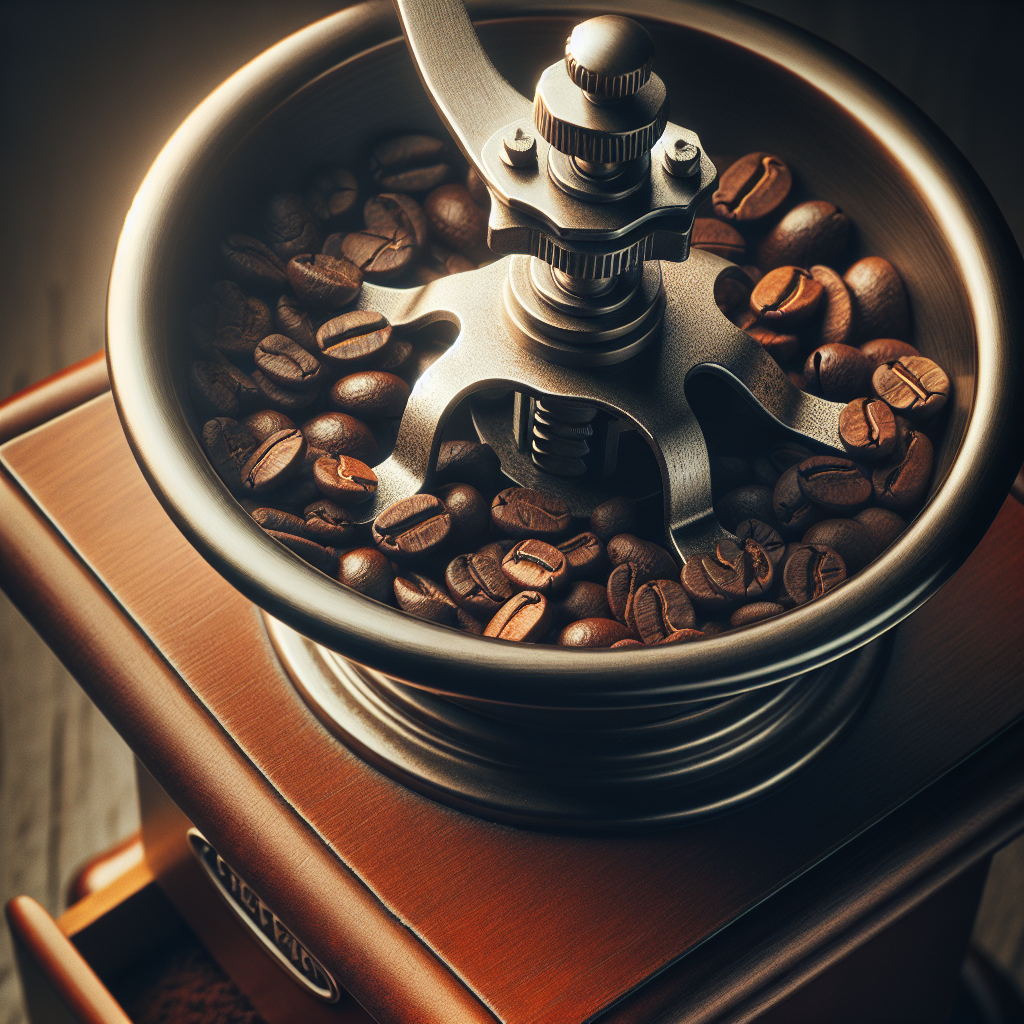At HopaCoffee.com, we are passionate about delivering an elevated coffee experience to our customers. We understand that the perfect cup of coffee starts with the right grind. That’s why we have delved into the science behind grinding for different coffee methods. Whether you prefer a French press, pour-over, or espresso, the grind size can greatly impact the taste and aroma of your coffee. Join us as we explore the intricacies of grinding and uncover the secrets to brewing the perfect cup of coffee for your preferred method.

The Importance of Grinding in Coffee Brewing
At HopaCoffee.com, we understand that grinding plays a crucial role in the coffee brewing process. The grind size of your coffee beans determines the rate at which flavor is extracted, ultimately affecting the taste and quality of your cup of joe. In this comprehensive article, we will explore the significance of grind size in coffee extraction, how it affects the flavor profile, and provide insights into the grinding process. Whether you are a coffee aficionado or just passionate about your daily dose of caffeine, understanding the importance of grinding is essential for achieving the perfect cup every time.
The Role of Grind Size in Coffee Extraction
Grind size directly impacts the rate at which the coffee is extracted during the brewing process. The extraction process involves dissolving the desirable compounds from the coffee grounds into water, resulting in the flavors and aromas we love. When the grind size is too fine, the coffee particles have a larger surface area and come into contact with water more quickly. This leads to a faster extraction and can result in over-extraction, giving your coffee a bitter taste. On the other hand, if the grind size is too coarse, the extraction process is slower, resulting in under-extraction and a weak, sour, or acidic coffee.
How Grind Size Affects Coffee Flavor
Grind size has a significant impact on the flavor profile of your coffee. Different brewing methods require different grind sizes to achieve optimal flavor extraction. The surface area of the coffee particles determines how much of the desirable compounds are extracted, resulting in distinct flavors and characteristics. For example, a coarse grind for a French press allows for a longer brewing time, resulting in a full-bodied and robust cup of coffee. In contrast, a fine grind for espresso brewing offers a shorter extraction time, creating a concentrated and intense flavor profile. Understanding the relationship between grind size and flavor is key to brewing your perfect cup of coffee.
Understanding the Grinding Process
Before we delve into the specifics of grind size for different brewing methods, let’s understand the grinding process itself. Grinding coffee involves reducing whole coffee beans into smaller particles, exposing a larger surface area for extraction. There are various types of coffee grinders available, including blade grinders and burr grinders, each with their unique advantages and drawbacks. Additionally, one must consider whether to opt for a manual grinder, which provides a hands-on and precise experience, or an electric grinder for convenience and speed.
Grinding Basics
Choosing the Right Grinder
Selecting the right grinder is vital for achieving an optimal grind size. Blade grinders are commonly found in many households, but they tend to produce an inconsistent grind, with some particles finer or coarser than others. Burr grinders, on the other hand, offer superior precision and control over the grind size, resulting in a more even extraction. The choice between these two types of grinders depends on your preference for consistency and the brewing method you will be using.
Blade Grinders vs. Burr Grinders
Blade grinders use a spinning blade to chop the coffee beans into pieces. These grinders are often more affordable and readily available, making them an attractive option for many coffee enthusiasts. However, the lack of control over the grind size and inconsistent particle distribution can lead to subpar extraction and uneven flavors.
Burr grinders, on the other hand, feature two revolving abrasive surfaces that grind the beans to a uniform size. This design provides greater control over the grind size, allowing for more precise adjustments according to your brewing method. The consistent particle size achieved with a burr grinder ensures a more balanced extraction, enhancing the flavors and aromas in your cup of coffee.
Manual Grinders vs. Electric Grinders
When it comes to choosing between a manual or electric grinder, it ultimately boils down to personal preference and convenience. Manual grinders offer a hands-on experience, allowing you to have complete control over the grinding process. They are often compact and portable, making them ideal for traveling or outdoor adventures. However, manual grinding can be time-consuming, especially if you need to grind a large quantity of coffee.
Electric grinders, on the other hand, provide ease and speed. With just a push of a button, you can effortlessly grind your coffee beans to the desired consistency. Electric grinders often come with various grind settings, offering versatility for different brewing methods. While they may require a power source and take up more countertop space, the convenience they offer can outweigh these factors for many coffee lovers. Ultimately, the choice between manual and electric grinders depends on your lifestyle and brewing preferences.
Grinding for Specific Brewing Methods
Now that we have covered the basics of grinding, let’s dive into grind size recommendations for specific brewing methods. Each method requires a specific grind size to achieve optimal extraction and flavor accuracy.
Grinding for Pour Over Coffee
For pour over coffee methods such as V60, Chemex, or Kalita Wave, a medium-fine to medium grind size is recommended. The goal is to achieve a balanced extraction that showcases the coffee’s delicate flavors. A medium-fine grind allows for a controlled brewing time and promotes a clean cup with clarity and brightness.
Grinding for French Press
French press brewing demands a coarse grind size to facilitate the longer brewing time required. The coarse grind allows for a gentle and thorough extraction, resulting in a rich and full-bodied cup of coffee. The larger grind particles also aid in the separation of the coffee grounds, preventing sediment from ending up in your mug.
Grinding for Espresso
Espresso brewing requires a fine and consistent grind size. The fine grind allows for a quick extraction under high pressure, resulting in a concentrated and intense flavor profile. A consistent grind size ensures an even extraction, avoiding any inconsistencies in flavor. It is crucial to invest in a high-quality grinder capable of achieving the fine grind needed for espresso brewing.
Grinding for Turkish Coffee
Turkish coffee, renowned for its unique preparation method, requires an extremely fine grind. The coffee is ground to a powder-like consistency, almost resembling flour. This powdery texture allows for a quick extraction in the traditional Turkish cezve pot, resulting in a robust and full-bodied cup of coffee. Achieving the right grind size for Turkish coffee often requires specialty grinders with specific settings.
Adjusting Grind Size
Understanding how to adjust the grind size according to different brewing methods is essential for achieving the desired flavor profile in your coffee.
The Relationship Between Brew Time and Grind Size
In general, a finer grind size leads to a shorter brewing time, while a coarser grind size prolongs the brewing process. Experimenting with different grind sizes is key to finding your preferred balance of flavor and strength. If your coffee is too weak or lacks character, try using a finer grind to increase extraction. On the other hand, if your coffee tastes bitter or over-extracted, a coarser grind may be necessary to reduce extraction time.
How to Adjust Grind Size for Different Brewing Methods
To adjust the grind size, start by making small increments or decrements and observe the impact on flavor extraction. If your coffee tastes weak or under-extracted, try a slightly finer grind. Conversely, if your coffee is bitter or over-extracted, coarsen the grind size. Keep in mind that each brewing method has its unique requirements, so it may take some experimentation to find your perfect grind size. Take notes, make adjustments, and enjoy the journey of discovering the ideal flavor balance.

The Science Behind Different Grind Sizes
To truly comprehend the significance of grind size, it is essential to delve into the science behind it. Two crucial aspects to consider are particle size distribution and the effects of uniformity and consistency.
Understanding Particle Size Distribution
Particle size distribution refers to the range of grind sizes present in a batch of coffee grounds. A narrower particle size distribution indicates a more consistent grind size, which is crucial for an even extraction. When the particle size distribution is wide, extraction becomes imbalanced, resulting in both under-extracted and over-extracted flavors coexisting in the same cup. Investing in a high-quality grinder that can achieve a consistent particle size distribution is key to brewing coffee with balanced flavors.
The Effects of Uniformity and Consistency in Grind Size
Uniformity and consistency in grind size directly impact the extraction process and the resulting flavors. If the grind size is inconsistent, some particles will be over-extracted, while others remain under-extracted. This creates an unbalanced and muddled flavor profile. The consistency of grind size ensures uniform extraction, allowing the desired flavors to shine through. Burr grinders, known for their precision and consistency, are a great choice for achieving optimal extraction and flavor clarity.
Factors to Consider When Grinding Coffee
While grind size is crucial, several other factors influence the coffee brewing process and the final cup’s flavor profile.
The Impact of Bean Origin and Roast Level
The origin of the coffee beans and the roast level also play a role in determining the optimal grind size. Different coffee beans possess unique flavors, densities, and moisture contents, which affect how they should be ground. Lighter roasts tend to be denser and require a slightly coarser grind to avoid over-extraction, while darker roasts are often less dense and benefit from a finer grind for thorough extraction. Experimenting with grind size based on bean origin and roast level can help unlock the full potential of your coffee.
The Influence of Water Temperature and Brew Time on Grind Size
Water temperature and brew time also impact the extraction process and flavor profile. Hot water extracts flavors more quickly, so a finer grind size may be necessary to ensure proper extraction within a shorter brewing time. Cooler water, on the other hand, may require a slightly coarser grind size to extend the extraction time and achieve balanced flavors. Additionally, brewing methods that allow for longer contact time, such as French press, can benefit from a coarser grind size to prevent over-extraction and bitterness.

Grinding Tips and Techniques
To ensure consistent and exceptional coffee brewing experiences, it is important to consider proper storage and maintenance of your coffee grinders, as well as follow a few dos and don’ts for optimal flavor.
Storing and Maintaining Coffee Grinders
Coffee grinders should be stored in a cool, dry place away from direct sunlight and moisture. This helps preserve the quality of the coffee beans and prevents any adverse effects on the grinder itself. Regular cleaning of the grinder, especially if oils from the coffee beans accumulate, is also essential to prevent any rancid flavors from tainting future brews. Follow the manufacturer’s instructions for cleaning and maintenance, and always use a brush to remove any residue from the grinder burrs.
Grinding Dos and Don’ts for Optimal Flavor
To achieve the best possible flavor extraction, we recommend the following dos and don’ts:
- Do use freshly roasted coffee beans to maximize flavor potential.
- Do grind your coffee just before brewing to preserve freshness and avoid flavor degradation.
- Do experiment with different grind sizes to find your preferred flavor profile.
- Don’t use a blade grinder if consistency is important to you.
- Don’t grind coffee beans in large batches if not needed, as it can lead to flavor loss.
- Don’t forget to clean your grinder regularly to maintain optimal performance.
The Role of Brewing Equipment in Grind Size
The choice of brewing equipment can also impact the grind size selection and ultimately affect the flavors in your cup of coffee.
The Impact of Coffee Makers and Brewing Devices on Grind Size
Different coffee makers and brewing devices have their unique design and functionality, which can influence the optimal grind size. Some coffee makers, such as automatic drip machines, benefit from a medium grind size to allow for proper water flow and extraction. AeroPress, a popular manual brewing method, typically requires a finer grind for a quicker extraction. Understanding the capabilities and limitations of your brewing equipment is key to adjusting the grind size accordingly.
Choosing the Right Brewing Equipment for Your Preferred Grind Size
If you have a preferred brewing method that requires a specific grind size, it is important to choose the right brewing equipment that can accommodate your needs. Consider the grind size range the equipment can handle and whether it allows for adjustments to achieve your desired flavor profile. Investing in brewing equipment that aligns with your preferred grind size ensures consistency and optimal flavor extraction.
Common Grinding Mistakes to Avoid
When it comes to grinding coffee, there are a few common mistakes that can negatively impact the flavor and quality of your brew.
Over-Extraction and Under-Extraction
Over-extraction occurs when the coffee is brewed for too long or the grind size is too fine, resulting in an excessively strong and bitter cup of coffee. Under-extraction, on the other hand, happens when the coffee is not brewed for long enough or the grind size is too coarse, resulting in a weak and sour cup. Finding the right balance of extraction is crucial for a well-rounded and flavorful cup of coffee.
Inconsistent Grind Size
Inconsistency in grind size can lead to an uneven extraction, resulting in a muddled and imbalanced flavor profile. Ensure that your grinder provides a consistent grind size to produce a consistent and delicious cup of coffee.
Not Adjusting Grind Size for Different Coffees
Different coffee beans possess unique characteristics and flavors. Failing to adjust the grind size according to the specific coffee being used can lead to under-extraction or over-extraction. Experimenting with grind size for each coffee variety can help bring out the best flavors and aromas in your brew.
Exploring New Grinding Techniques
The world of coffee is constantly evolving, and there are always new techniques and equipment emerging to enhance your coffee experience.
Alternative Grinding Methods and Equipment
While blade grinders and burr grinders are the most commonly used, there are alternative grinding methods and equipment worth exploring. Hand grinders, often referred to as manual grinders, offer a different brewing experience and allow for greater control over the grind size. Some coffee enthusiasts even use specialty methods like the “hammer” or “grind on demand” to experiment with unique flavors and extraction dynamics. As coffee lovers, we encourage you to explore and discover new techniques that resonate with your taste preferences and brewing style.
Innovative Approaches to Achieving the Perfect Grind
Developments in technology and innovation have led to the creation of innovative grinding equipment. Some grinders now come with built-in scales, timers, and even connected apps that allow you to control and monitor the grinding process with precision. These advancements provide coffee enthusiasts with enhanced accuracy and repeatability, further refining the coffee brewing experience. Keep an eye out for new products and technologies that can take your grinding game to the next level.
In conclusion, the art and science of grinding are essential aspects of the coffee brewing process. The grind size directly impacts the rate of extraction and the resulting flavor profile. Understanding the role of grinding and the nuances of grind size for different brewing methods allow you to unlock the full potential of your coffee beans. With the right grinder, brewing equipment, and a willingness to experiment, you can consistently brew exceptional cups of coffee that showcase the intricate flavors and aromas of your favorite beans. So, grab your grinder, explore different grind sizes, and elevate your coffee experience one brew at a time. Cheers to a perfectly ground and brewed cup of coffee!

